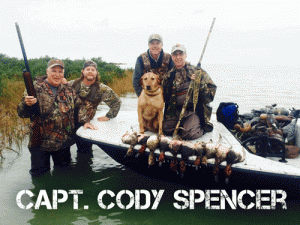
Captain Cody Spencer takes longtime friend of Captain Chris Martin, 33 years, Ray Proctor, duck hunting.
One of the hardest things to do when fishing at this time in the year is determining productive water, and probably one of the best ways to do this is to not venture into areas where you know the fishing will be unproductive due to winter weather conditions. Learn to focus on places that typically hold quality fish on a seasonal basis. This can be somewhat of a monstrous task accomplish when the weather is nice, but when the wind and water turn chilly it can become even a bigger challenge. As a generic rule, fishing deeper water in wintertime tends to be more productive, and our San Antonio Bay system offers quite a few of what have long been some of the coast’s more legendary cold-weather sites and deep-hole hot spots like the Army Hole, the Port O’Connor jetties, the boat basin at Matagorda, and the Intracoastal Waterway (ICW). But, even closer to the Seadrift area is the Victoria Barge Canal. The thirty-five mile Victoria Barge Canal was completed to a navigable depth of 9-feet and to a width of 100-feet in 1968, but now matches the size and depth of the ICW with which it connects. Thus, the canal offers deep-water access for fish and protection from the elements for anglers during the colder times of the year, and the deep water attributes of the canal have often proven to be a great place to find wintertime trout that are staging themselves within its confines.
A lot of coastal anglers probably don’t get to spend the amount of time required out on the water in order to know where the fish are located on a day-to-day basis, especially during winter in the Victoria Barge Canal. So, in an effort to help alleviate some of the frustration, here are a few productive tips that might prove helpful while fishing in the canal during the winter months. First and foremost, do not go in the canal under the assumption that you are going to be wading fishing. The floor of the canal is occasionally covered in treacherous mud and silt, making it difficult to navigate on foot, and the banks of the canal drop-off irregularly and sometimes very rapidly. Additionally, if you were to be wading the shore of the canal at the time of barge traffic, you could very well find yourself in a tough, if not threatening, situation. Many folks prefer drift fishing in the canal, and have found it to be quite successful during this period of the year. A lot of times the fish will be on one side or the other of the canal when the temperature drops, and the only way to locate them is simply through trial and error. In this situation, your first choice should be to setup a drift depending on the wind direction, drifting whichever side of the canal that happens to coincide with the direction that the wind is blowing. However, when the temperature really drops, you will probably find most of the boats drifting across the midsection of the canal in order to take full advantage of the 12-foot depth.
If the water is clear in the canal, drift until you locate the bite and then anchor while tossing a soft-plastic lure up and down the center of the canal. In clear water, try to vary the depth of your lure between 5 to 12-feet while looking for staging fish. As temperatures warm, the fish will move closer to the top, and regular success can be experienced while fishing plastic baits beneath a popping cork nearer to the bank of the canal in 5 to 6-feet of water. But remember, temperature means everything here, so if it’s really cold the fish will be on the bottom. Now, if the water in the canal is muddy you may not wish to waste valuable time by stopping to set the anchor and cast. In muddy water, simply drift while casting your lure and letting it sink completely before bumping it across the bottom and back to the boat. One other item of mention with regards to the canal is that you can never discount tidal movement. As like most any other fishing spot along the coast, most anglers have learned that you need tidal movement in the canal if you expect to have results. A low tide or a high tide does not seem to matter, but you need one or the other. No tidal movement in the canal generally means “no fish” as a direct result.
In closing this edition of Guide Lines, Bay Flats Lodge wishes to remind everyone of our 2016 FEBRUARY FISHING SPECIAL. The dates include all days in February 2016, and it’s a time during the year when you and your guests can enjoy all the benefits of Bay Flats Lodge and their staff of professionals at a discounted rate. Remember to practice CPR, “Catch, Photo, and Release”, whenever possible on trophy Trout and Reds…Guide Chris Martin, Port O’Connor/Seadrift region. www.BayFlatsLodge.com…1-888-677-4868.
